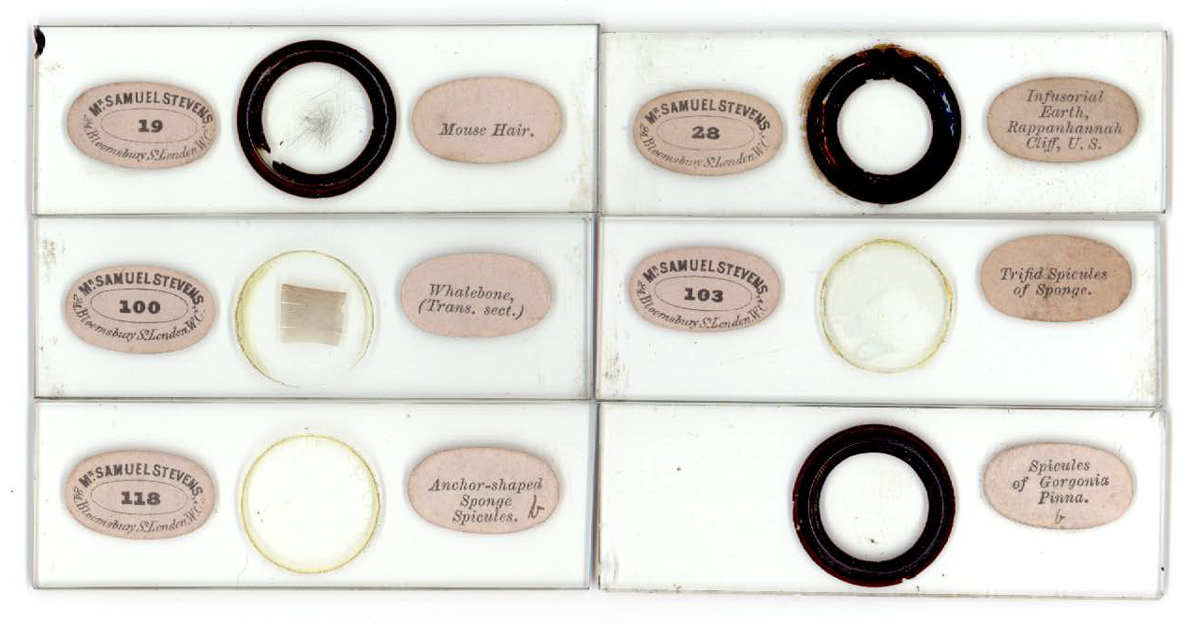
Samuel Stevens, Naturalist (1817-1899)
by Brian Stevenson, Lexington, Kentucky, USA
Students of antique microscopy may know of Samuel Stevens from the distinctive slides which he sold from his shop at 24 Bloomsbury Street, London. Most are probably not aware that Stevens played important, supporting roles in shaping evolutionary theory.
Stevens opened the Natural History Agency in 1848, then sold the business in 1867. The microscope slides he sold bear two horizontal oval labels, the right one having an imprinted description of the specimen, and the left label having Stevens’ imprinted name and address, plus a number (Figure 1). These numbers were part of an efficient selling scheme, by which customers could chose the specimens they preferred from a printed list, then order their selections using the corresponding number (Figure 2). It was much like the menu system used in many restaurants today. This would have allowed error-free ordering through messengers or by post, as well as simplifying the ordering process on site. The slides were evidently mass produced by anonymous preparers. Most specimens on the 1855 list are of types conducive to efficient, large scale production, such as strewn butterfly wing scales, sponge spicules and infusorial (diatomaceous) earth. Stevens also offered pre-packaged sets of one or two dozen slides on topics such as mollusk palates, gorgonia spicules, or bones and teeth. The slide shown at the bottom right of Figure 1 may have originated from one of those sets, as the subject is not found on Stevens’ numbered list (Figure 2).

Figure 1. Six slides from Samuel Stevens’ Natural History Agency, dating between 1848 and 1867. The five slides with an address and number label match items in his published lists (see Figure 2). The sixth slide, Spicules of Gorgonia Pinna (lower right), does not match an item in the numbered menus, and may represent a component of one of Stevens’ pre-assembled sets of slides (see the bottom of the list shown in Figure 2).
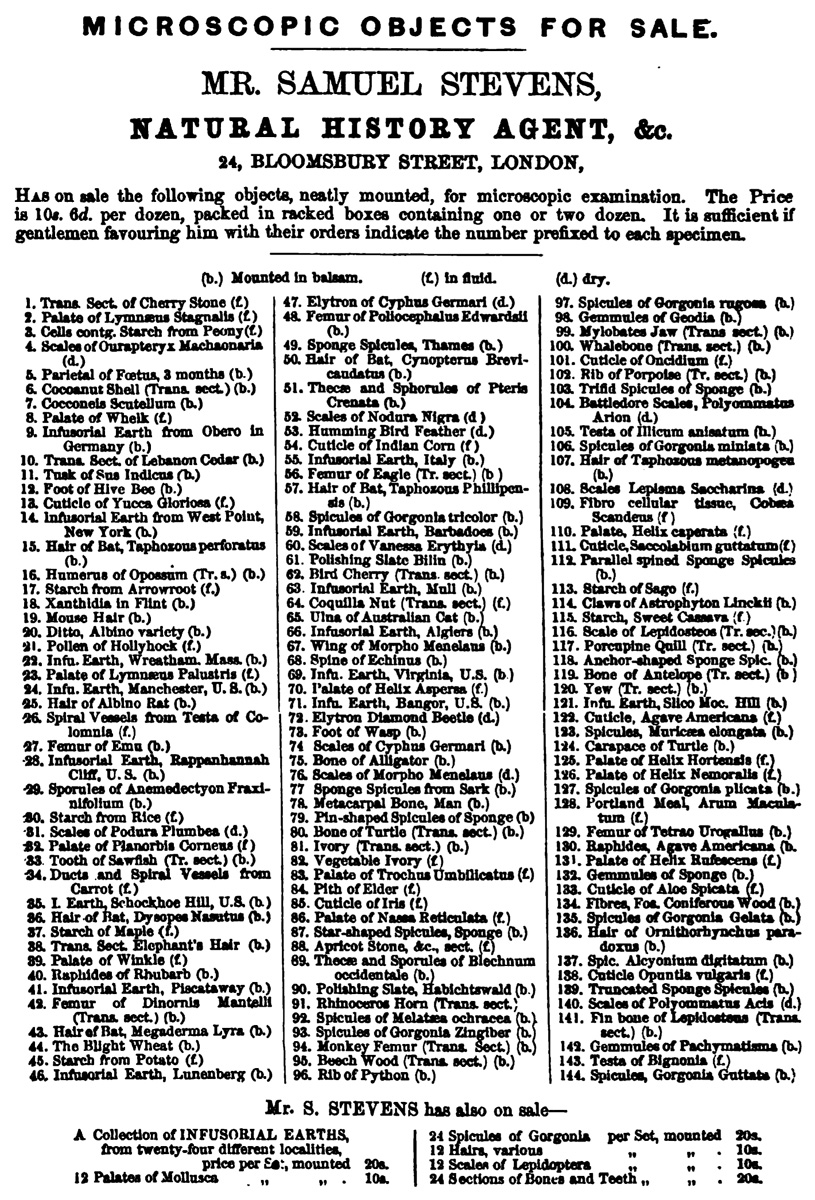
Figure 2. Samuel Stevens’ list of 144 microscopical individual objects, and 6 groups of 1 or 2 dozen pre-assembled collections. From J. Quekett’s 1855 “A Practical Treatise on the Microscope.” An identical list was printed in Jabez Hogg’s 1856 “The Microscope.” Printed lists could also be obtained directly from Stevens.
An 1857 article on microscopy in Household Words, apparently written by Charles Dickens, stated, “To come to financial particulars. Mr. Samuel Stevens, the well-known natural-history agent, of Bloomsbury Street, has on sale good preparations elegantly mounted and packed in neat boxes containing one or two dozen, at half-a-guinea per dozen. His published list offers a choice of more than two hundred numbered objects of great variety. To point out a few; the palates of snails and of freshwater and marine mollusks are very remarkable. When we see a soft snail eating a hard cabbage-leaf or carrot - if we reflected on the operation - we must conclude that it cannot be performed without the agency of teeth. The microscope shows us, in a well-prepared palate from a land or water-snail, rows upon rows of teeth, containing altogether hundreds and hundreds of molars. The shark devours animal food, and so does the whelk. But, talk of a shark's rows of teeth! they are nothing to the weapons that line the mouth of a whelk, - half-a-dozen in each row in the middle, with a chevaux-de-frise of tusks on either side. Are a dozen different mollusk palates - ready for comparison and study - dear at half-a-guinea? Simply think of the time and cost, requisite to produce them as home-made articles.”
Stevens’ Natural History Agency was far more than just a place to purchase microscope slides. He also sold specimens from the far corners of the Earth, brought or sent back by explorers. Examples of advertisement of such exotica are shown in Figure 3. Stevens’ support in selling those items was critical to the successes of exploring and collecting expeditions, as he would send profits from the sales back to the collectors, allowing them to stay in the field for years on end. Stevens charged a 20 percent commission on those sales, plus an additional 5 percent for insurance and freight. An example of a going retail price was 4 pence per insect, which would return 3 pence to the collector. Stevens wrote his 1855 Directions for Collecting and Preserving Specimens of Natural History in Tropical Climates in large part to assist those explorer-collectors. The Jamaican snail species Petitia stevensiana (now Fadyenia stevensiana) was named by Edward Chitty “in complement to the naturalist’s universal friend, S. Stevens, Esq., Bloomsbury Street, London.”
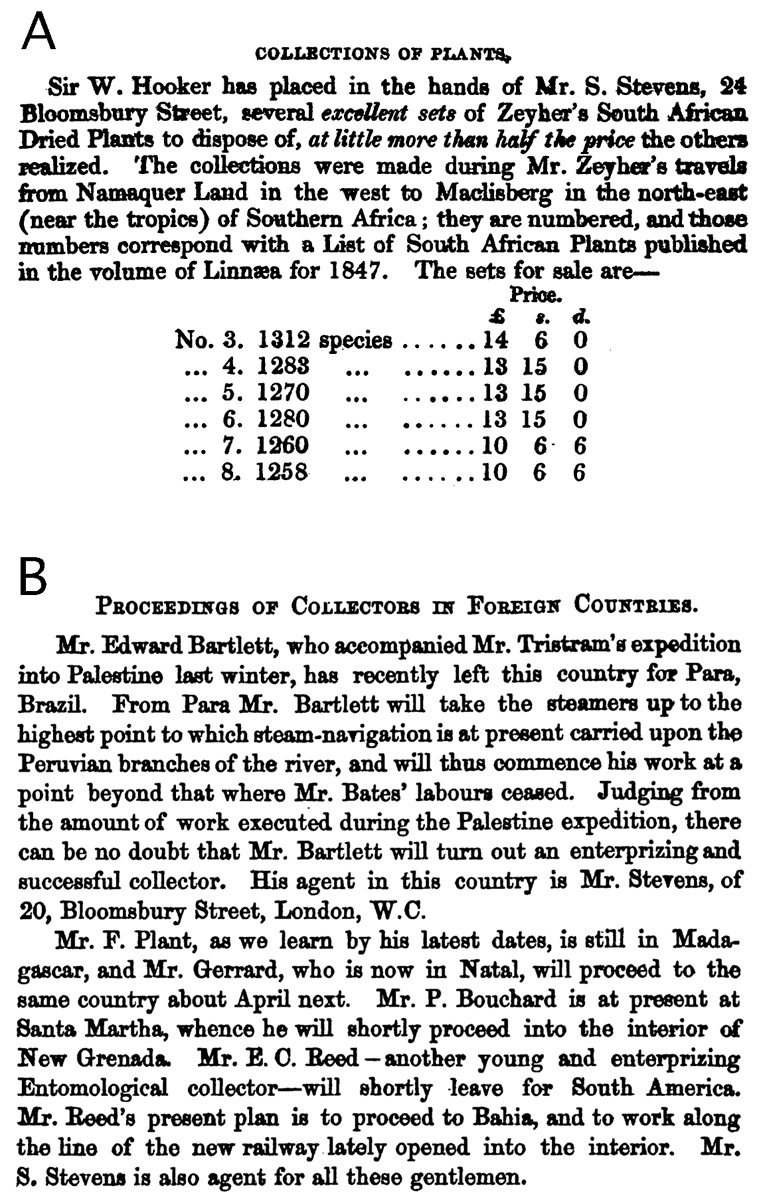
The two most famous explorer-collectors supported by Stevens were Alfred Russel Wallace and Henry Bates, both of whom played significant roles in the early development of evolutionary theory. Wallace wrote influential works on evolution, and his ideas spurred Charles Darwin to publish his own work. Bates is perhaps best known for describing what is now known as Batesian mimicry, in which a palatable species mimics the colors, shape, etc. of an unpalatable species, and is thus likely to be avoided by possible predators. Bates’ theory arose from his studies of butterflies while collecting them in the Amazon. As with so many other explorers, Stevens helped outfit Wallace and Bates for their expeditions, sold their specimens, and managed their money while they were away. Stevens had a reputation as a frugal, honest money manager.
Physical support was also provided when necessary. Wallace shipwrecked during his return from South America in 1852. When Wallace arrived in England wearing rags and without any luggage, Stevens bought Wallace new suits of clothes. He then put Wallace up at his home, where Stevens’ mother cared for Wallace to help him regain his lost weight.
Stevens actively promoted his clients, showing their specimens at naturalist society meetings. He was an early member of the Entomological Society of London, having been elected in 1837, as well as being a Fellow of the Linnaean Society. He showed off Wallace to the Entomological Society three days after the castaway returned to England. Among recorded minutes of that society’s meetings are reports of Stevens exhibiting South American insect specimens from Wallace and Bates in 1849, beetles from Borneo by Wallace in 1855, and insects from Africa by C.J. Andersson in 1865. Stevens also used his connections to actively recruit support for explorers, such as his appeal to the Entomological Society in 1858 for subscribers to support Richard Shield’s quest for insects and other specimens in South America. Such subscribers would pay in advance for specimens to be delivered later, thereby providing the collector with cash to initiate his adventure.
These connections, exhibits and appeals also led to support from other prominent naturalists. In 1850, Edward Newman, editor of The Zoologist wrote, “Ega, Upper Amazons, whence several specimens have been sent home by Mr. Bates, now engaged in forming entomological collections in that rich country. To the untiring energy of this able naturalist we are indebted for vast and almost incalculable additions to our knowledge of the insect Fauna of the South American Continent. Mr. Bates is continually transmitting the proceeds of his labours to Mr. S. Stevens, of 24, Bloomsbury Street; and as the prosecution of his researches must very much depend on the success of Mr. Stevens in disposing of these collections, I venture to express a sincere hope that those entomologists who possess the power of doing so, will lend their pecuniary assistance to Mr. Bates, by becoming purchasers of his captures, and thus furnish him with the means of continuing and extending his invaluable researches. I must not allow this appeal to go forth, without distinctly stating that it is perfectly spontaneous on my part, and altogether unsolicited either by Mr. Stevens or Mr. Bates; but that it is not otherwise than a necessary one, may be seen by a reference to Mr. Bates' own observations at p. 2966 of the present number. I should also add, that when I mention an insect as in the collection of Mr. Stevens, I wish it to be understood as intimating merely that it is consigned to that gentleman's care, and is to be obtained on application.”
In addition to microscope slides and exotic biological specimens, one could almost completely outfit an expeditions from Stevens’ shop. Figure 4 is excerpted from an article by Henry Bates on preparing oneself for an adventure.
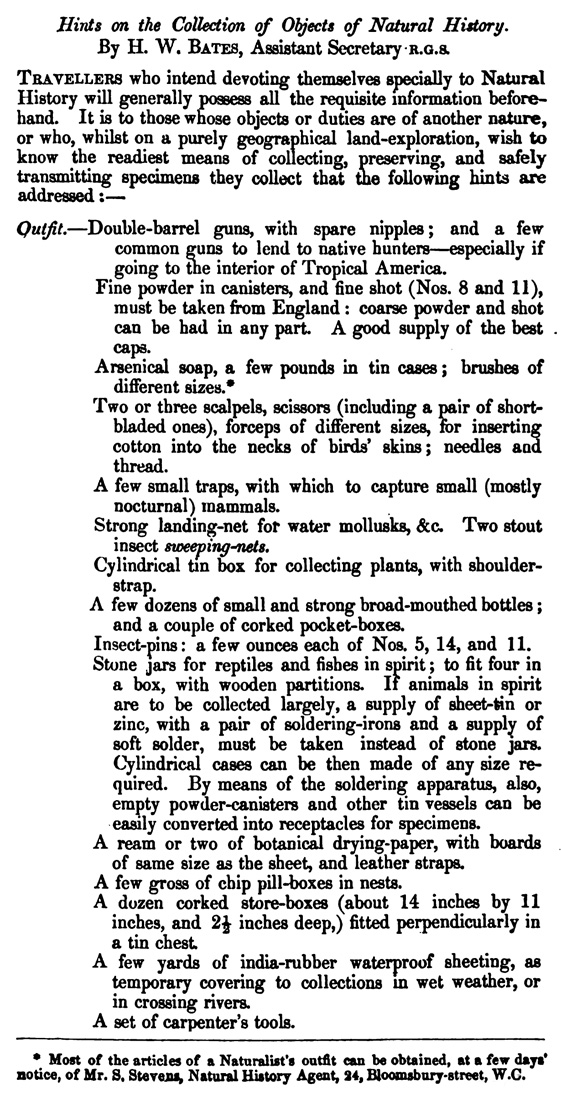
Figure 4. A list of essential equipment for the 19th century adventurer. Almost everything on the list could be obtained directly from Samuel Stevens. From H.W. Bates (1864) Journal of the Royal Geographical Society, vol. 34, pages 306-307
Samuel Stevens was born 11 March, 1817, in St. Martin in the Fields, Middlesex. As a child, he developed great skill at drawing, and at the age of thirteen won a Royal Society of Arts medal for his pencil work. His parents worried that focusing on art would harm Samuel’s delicate health, so he took up collecting and studying natural objects. Entomology became a major attraction for him. In 1840, Samuel joined his brother John as a partner in the J.C. Stevens Auction Rooms. In 1848, he left the auction business to open his Natural History Agency. After his brother John died in 1859, Samuel also ran the Auction Rooms, retaining the name of J.C. Stevens. In 1867, Stevens sold the Natural History Agency to E.T. Higgins, who then operated the establishment until at least 1876. Stevens apparently devoted much of his time thereafter to his hobbies, in particular entomology. He lived with his widowed mother, Augusta, for much of his adult life, being recorded as living in her household on the 1851 and 1861 censuses. Augusta died in 1868. At the time of the 1871 census, Samuel Stevens was lodging with an “office messenger” and his family in Covent Gardens. Long-time bachelor Samuel married in 1874, at the age of 57, to Frances Wood, age 61. They lived at “Loanda”, in Beulah Hill, Croydon, Surrey. The 1881 census described Stevens as living on “income derived from dividends”, probably related to his reputed conservative money management. Frances died sometime between 1881 and 1891. Samuel died 29 August, 1899 at the age of 83, at Loanda. Much of Samuel Stevens’ collection of insects and other natural items were sold at the J.C. Stevens Auction Rooms in March, 1900 (Figure 5).
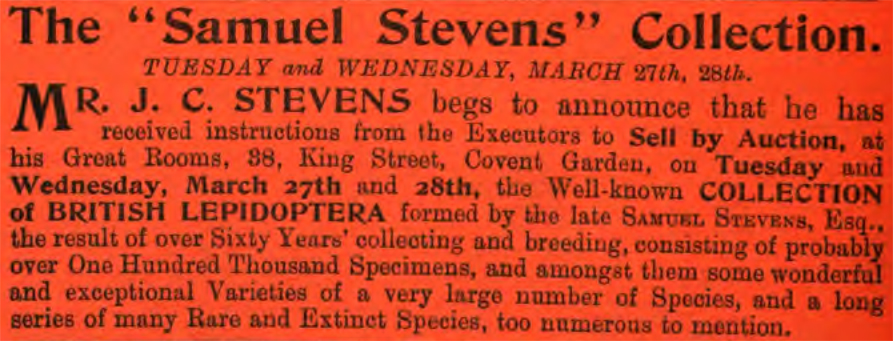
Figure 5. Announcement of the sale of Samuel Stevens’ collection of natural history items, 1900. J.C. Stevens was Samuel’s brother, who died 41 years earlier, in 1859. The heirs retained the business name, and generally advertised as if J.C. were a living person.
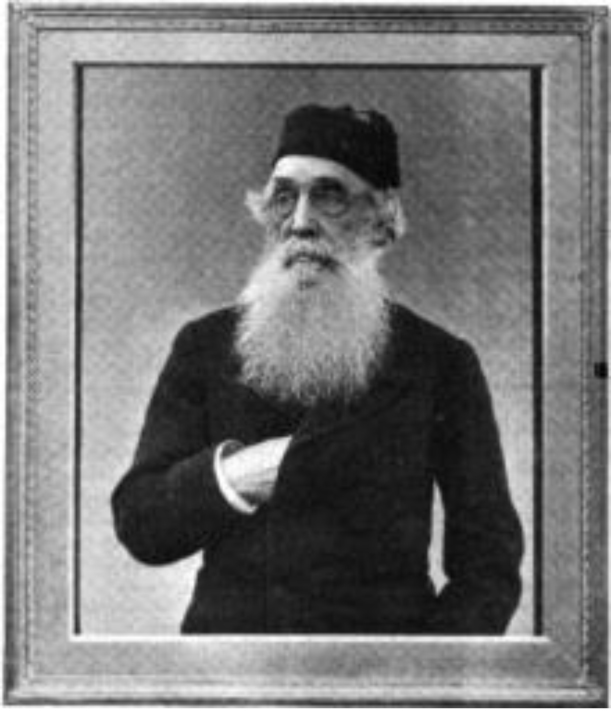
Figure 6. Photograph of Samuel Stevens, taken within a few years of his death. He was standing behind an empty picture frame, in a pose that illustrates Stevens’ sense of humor. The photo was taken by Samuel’s nephew, Henry Stevens, then manager of the J.C. Stevens Auction Rooms. From Hardwicke’s Science-gossip, 1899, new series, volume 5, page 161.
Comments
will be welcomed by the author.
Resources
The Alfred Russel Wallace Reader (2002) ed. by Jane R. Camerini, Johns Hopkins Press, Baltimore, Maryland
Bates, Henry W. (1863, new edition 1864) The Naturalist on the Amazons, numerous reprinted versions of this classic are available.
Bates, Henry W. (1864) Hints on the collection of objects of natural history, Journal of the Royal Geographical Society, vol. 34, pages 306-307
The Botanical Gazette, 1850, vol. 2, page 56
Chitty, Edward (1857) On Stoastomidae as a family, and on seven proposed new genera, sixty one new species, and two new varieties from Jamaica, Proceedings of the Zoological Society of London, part 25, pages 162-201
Dickens, Charles (1857) Household Words, page 136
English vital statistics, accessed through ancestry.co.uk
The Entomologist (1899) Obituary of Samuel Stevens, vol. 32, no. 437, October, page 264
The Entomologist’s Monthly Magazine (1900), 2nd series, vol. 11, page 48
The Entomologist’s Monthly Magazine (1903) Obituary of John S. Stevens, 2nd series, vol. 14 page 229
Entomologist's Weekly Intelligencer (1858) vol. 3, no. 2, Feb. 13, page 168
Hardwicke’s Science-Gossip (1899) Obituary of Samuel Stevens, New series, vol. 5, page 161
Infinite Tropics, an Alfred Russel Wallace Anthology (2002) ed. by Andrew Berry, Verso, London
The Naturalists' Directory (1866) “John S. Stevens”, Appendix, page 8
Nature (1872) advertisement from E. Higgins, vol. 6, Sept. 19, page lxxxiv
Nature (1897) advertisement from J.C. Stevens Auction Rooms, vol. 56, May 13, page xi
Newman, Edward (1850) The Zoologist, vol. 8, page cxxi
Notes and Queries (1856), 2nd series, vol. 1, Feb. 2, page 105
Quekett, John (1855) A Practical Treatise on the Microscope, 3rd edition, advertisements at back of the book
Slotten, Ross A. (2004) The Heretic in Darwin's Court, Columbia University Press, New York
Stevens, Samuel, (1855) Directions for Collecting and Preserving Specimens of Natural History in Tropical Climates, Linnaean Society of London
Transactions of the Entomological Society of London (1855) new series, vol. 3, pages 112-113
Transactions of the Entomological Society of London (1858) new series, vol. 5, page 11
Transactions of the Entomological Society of London (1865) third series, vol. 2, pages 125-126
Transactions of the Entomological Society of London (1866) third series, vol. 2, page xvi
Wallace, Alfred R. (1891) Natural Selection and Tropical Nature, new edition, Macmillan and Co., London
The Zoologist (1858) vol. 16, page 6036
The Zoologist (1899) Obituary of Samuel Stevens, 4th series, vol. 3, page 479
Microscopy UK Front
Page
Micscape
Magazine
Article
Library
Please report any Web problems or offer general comments to the Micscape Editor .
Micscape is the on-line monthly magazine of the Microscopy UK website at Microscopy-UK .